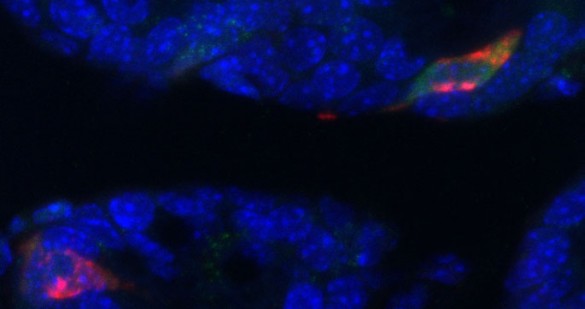
A receptor in the brain that regulates appetite and body weight has now been found in L cells, key regulatory cells in the gut, providing the pharmaceutical industry with a novel drug target for both obesity and diabetes, a Vanderbilt University-led research team reported this week.
Efforts to stimulate the melanocortin-4 receptor (MC4R) in the brain have produced significant weight loss, but also a centrally mediated increase in blood pressure. Thus, the latest finding, reported by the journal Cell Metabolism, “is an important shift in current thinking about drug development at the MC4R,” the researchers concluded.
“This finding represents the discovery of a new pathway for elevation of the bioactive products of L cells, such as plasma PYY and GLP-1,” said the paper’s corresponding author, Roger Cone, Ph.D., chair of the Department of Molecular Physiology and Biophysics and Joe C. Davis Professor of Biomedical Science at Vanderbilt.
PPY (peptide YY) reduces appetite by slowing gastric emptying, while GLP-1 (glucagon-like peptide-1), a potent anti-hyperglycemic hormone, induces glucose-dependent stimulation of insulin secretion to lower glucose levels in the blood and increase glucose update by the tissues.
Because the researchers demonstrated that MC4R stimulates PPY release in normal human colon tissue from surgical samples, “we also know this is a novel, valid drug target for diabetes, and potentially for obesity,” Cone said.
Cone is renowned for his research aimed at understanding how the central nervous system regulates energy stores — both the normal processes and the pathophysiological mechanisms that lead to obesity, metabolic syndrome, disease wasting, anorexia nervosa and other eating disorders.
A core theme of Cone’s research is the role of melanocortin peptides and receptors in these, and other physiological processes. His work has shown that melanocortin-containing circuits in the central nervous system are responsible for integrating information about energy intake and expenditure to keep body weight constant.
The current study involved the thesis work of graduate student Brandon Panaro, and a tri-national collaboration that included research teams led by Thue Schwartz, M.D., DMSc, at the University of Copenhagen and Helen Cox, Ph.D., at King’s College London.
In studies of mouse and human tissue, they found that MC4R was expressed in cells from the stomach to the colon. In addition, there was “significant enrichment” of the receptor in enteroendocrine “L” cells, which secrete GLP-1 and PYY.
Despite repeated public education campaigns advocating healthy nutrition and regular, vigorous exercise, a tidal wave of obesity threatens to overwhelm the U.S. health care system.
According to federal health officials, one in three adults is considered obese. The prevalence of obesity has more than doubled since the early 1960s and continues to rise. More than 25 million Americans have been diagnosed with diabetes, which increases the risk of heart disease, as well as kidney failure, blindness and nerve damage.
The study was supported in part by National Institutes of Health grants DK096527, DK070332, DK02059 and DK058404.












